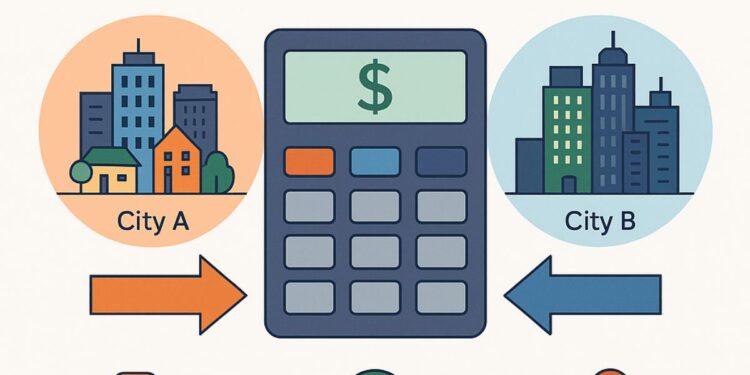When considering a move to a new city or country, understanding how far your money will go is essential. This is where a cost of living calculator becomes your most valuable tool. It helps you compare expenses, salaries, and lifestyle differences between locations, allowing you to make informed financial decisions.
A cost of living calculator uses real data—such as housing, transportation, healthcare, and taxes—to determine how your income translates across regions. Whether you’re planning a relocation for work, education, or lifestyle change, knowing these differences prevents financial surprises and ensures you maintain your quality of life.
Understanding What the Cost of Living Really Means
The cost of living refers to the total amount of money required to cover basic expenses such as housing, food, healthcare, and taxes in a particular area. This figure varies significantly from one place to another due to economic factors, local markets, and even climate.
Using a cost of living calculator gives you a clear picture of these variations. It answers questions like:
- How much more expensive is it to live in San Francisco than Austin?
- What salary do I need in London to enjoy the same lifestyle I have in Toronto?
- Is relocating to a smaller city worth it financially?
By comparing data across regions, these calculators empower users to plan wisely—whether you’re an employee evaluating a new job offer or a business expanding to new markets.
How a Cost of Living Calculator Works
At its core, a cost of living calculator analyzes and compares multiple economic indicators between two locations. The process involves three main inputs:
- Your current city
- Your current salary
- Your target city
Based on these inputs, the calculator estimates how your purchasing power changes. For example, if you earn $70,000 in Dallas, it may calculate that you need around $110,000 in New York City to maintain the same lifestyle.
Key Data Sources
Reputable calculators use data from organizations such as:
- U.S. Bureau of Labor Statistics (BLS)
- Numbeo and OECD databases
- Real estate and consumer spending reports
This ensures that the cost of living calculator provides accurate, regularly updated figures that reflect real-world market trends.
Key Expense Categories That Impact Living Costs
When using a cost of living calculator, it’s helpful to understand the key expense categories that drive regional cost differences:
Housing
The single largest expense for most households. Housing costs—rent or mortgage payments—can vary by over 200% between major cities.
Transportation
Includes vehicle ownership, fuel prices, insurance, and public transit. Urban areas often have higher public transport costs but lower vehicle expenses.
Food and Groceries
Local pricing, taxes, and import costs can greatly affect grocery budgets. Coastal cities, for instance, tend to have higher food prices.
Healthcare
Health insurance, prescriptions, and hospital services differ dramatically across states and countries.
Taxes
State or municipal income taxes, sales taxes, and property taxes have a direct impact on your disposable income.
Utilities
Electricity, water, heating, and internet costs all contribute to your monthly budget.
Understanding these categories helps you use a cost of living calculator effectively, tailoring it to your lifestyle and financial goals.
Using a Cost of Living Calculator to Plan a Move
Relocating can be exciting—but also financially challenging. Before making the leap, it’s vital to compare cities using a cost of living calculator. Here’s how to get the most accurate results:
- Input realistic figures: Include your actual salary and current location.
- Select your destination city: Choose one or multiple cities to compare.
- Analyze each expense category: Look beyond the total score; study which categories differ most.
- Adjust for your lifestyle: Single professionals, families, and retirees will experience different costs.
- Plan salary negotiations accordingly: If your new city’s cost of living is higher, use the calculator data to support a salary adjustment.
For example, someone moving from Atlanta to Seattle may find that housing is 40% more expensive but transportation is cheaper. This balance helps in budgeting more effectively.
Cost of Living Calculators for Salary Comparison
Many people use a cost of living calculator not just for relocation but also for salary comparison and job offers. Employers often adjust compensation based on city averages to maintain fairness and competitiveness.
Salary Adjustment Example
If a software engineer earning $80,000 in Denver moves to San Francisco, a cost of living calculator may suggest an equivalent salary of around $130,000 to maintain the same purchasing power. This insight is essential during salary negotiations.
When to Use It
- Evaluating remote job offers from different states or countries
- Requesting salary adjustments after relocation
- Comparing the real value of income across cities
By integrating accurate, updated data, these calculators help users make fair and informed career choices.
Real-World Examples of City Comparisons
To illustrate how a cost of living calculator works, here are some comparisons using 2024 average data:
| City A | City B | Salary Needed to Match Lifestyle | Difference |
|---|---|---|---|
| Austin, TX | San Francisco, CA | $75,000 → $128,000 | +70% |
| Berlin, Germany | London, UK | €50,000 → £70,000 | +40% |
| Toronto, Canada | Vancouver, Canada | CAD 80,000 → CAD 93,000 | +16% |
| Chicago, IL | New York, NY | $85,000 → $120,000 | +41% |
These figures demonstrate how dramatically costs can differ—and how valuable a cost of living calculator is when planning a move or career change.
Factors That Influence the Cost of Living
Beyond raw expenses, several economic and lifestyle factors affect living costs:
- Local job markets: Demand for talent influences wages and affordability.
- Inflation rates: Persistent inflation raises overall living expenses.
- Exchange rates: Critical for international comparisons.
- Government policies: Tax incentives, subsidies, and housing regulations alter costs.
- Lifestyle choices: Dining out, travel frequency, and entertainment can skew personal spending.
A cost of living calculator simplifies these complex variables into easy-to-understand comparisons, empowering users to make smarter life decisions.
Tips to Manage Expenses After Relocating
Once you’ve used a cost of living calculator and decided to move, smart money management becomes crucial. Here’s how to keep costs under control:
- Create a new city-specific budget: Adjust spending based on your new location’s cost data.
- Prioritize fixed costs: Focus on housing and utilities before discretionary spending.
- Explore local discounts: Many cities offer resident deals for transport or entertainment.
- Reevaluate subscriptions: Cancel services you no longer use.
- Track expenses: Use apps or spreadsheets to monitor monthly trends.
Applying these strategies ensures that your relocation remains financially sustainable long after the move.
Conclusion: Plan Smarter with the Right Insights
A cost of living calculator is more than just a comparison tool—it’s a roadmap to financial clarity. By understanding how income and expenses shift between cities, you can make confident decisions about moving, budgeting, or negotiating salaries.
Whether you’re changing jobs, exploring remote work, or simply curious about regional differences, integrating a cost of living calculator into your planning process guarantees a smarter, stress-free transition.
FAQs
1. What is a cost of living calculator used for?
It helps compare expenses and salaries between cities to determine how much money you’ll need to maintain your current lifestyle after relocating.
2. How accurate are cost of living calculators?
They use reliable data from government and research organizations, but results can vary slightly based on lifestyle differences and personal spending habits.
3. Can I use a cost of living calculator for international moves?
Yes. Many tools include international data and exchange rates to compare global destinations effectively.
4. Which expenses impact cost of living the most?
Housing, transportation, healthcare, and taxes typically have the largest impact.
5. How often should I check cost of living data?
Annually or before any major move, as local economies and inflation rates change frequently.
















